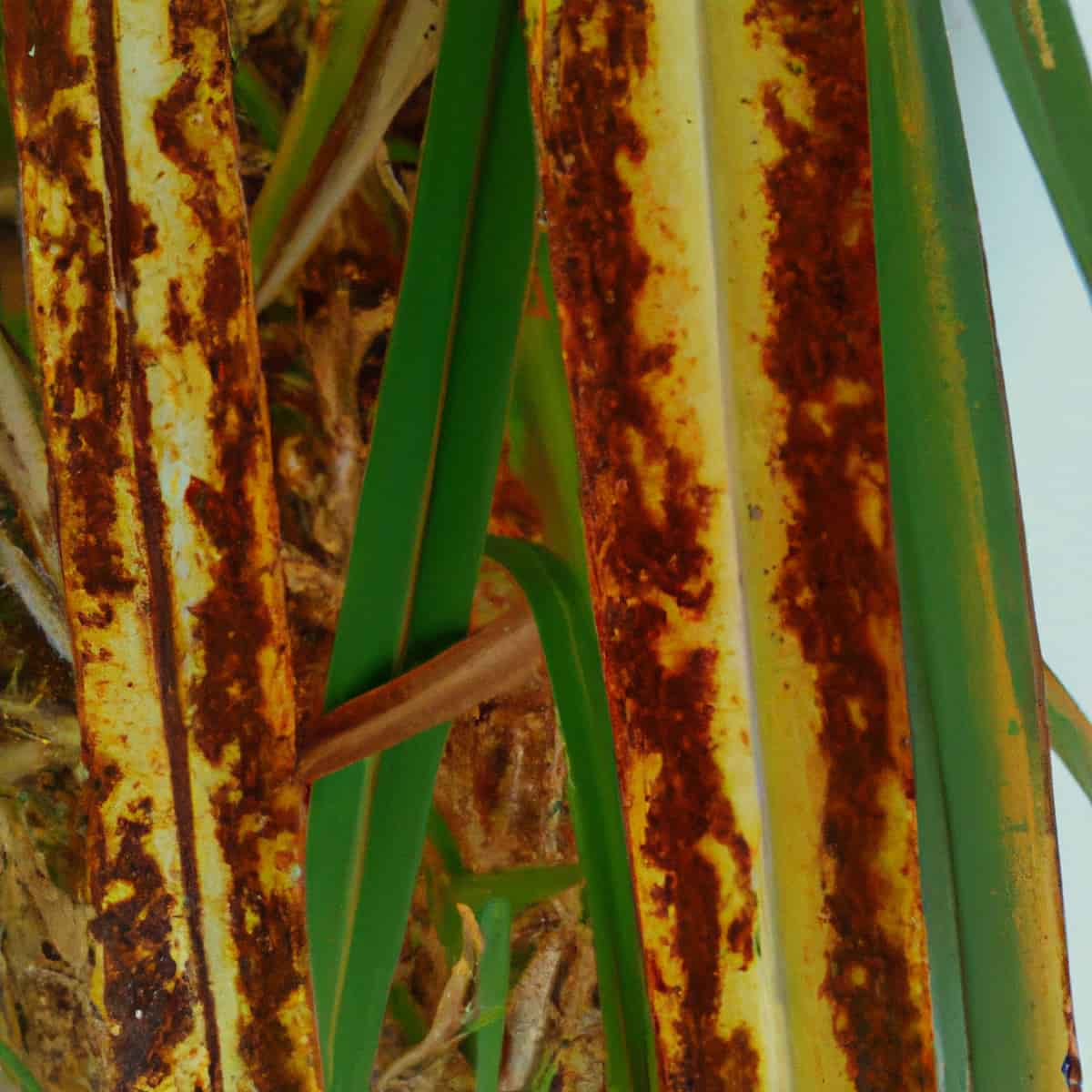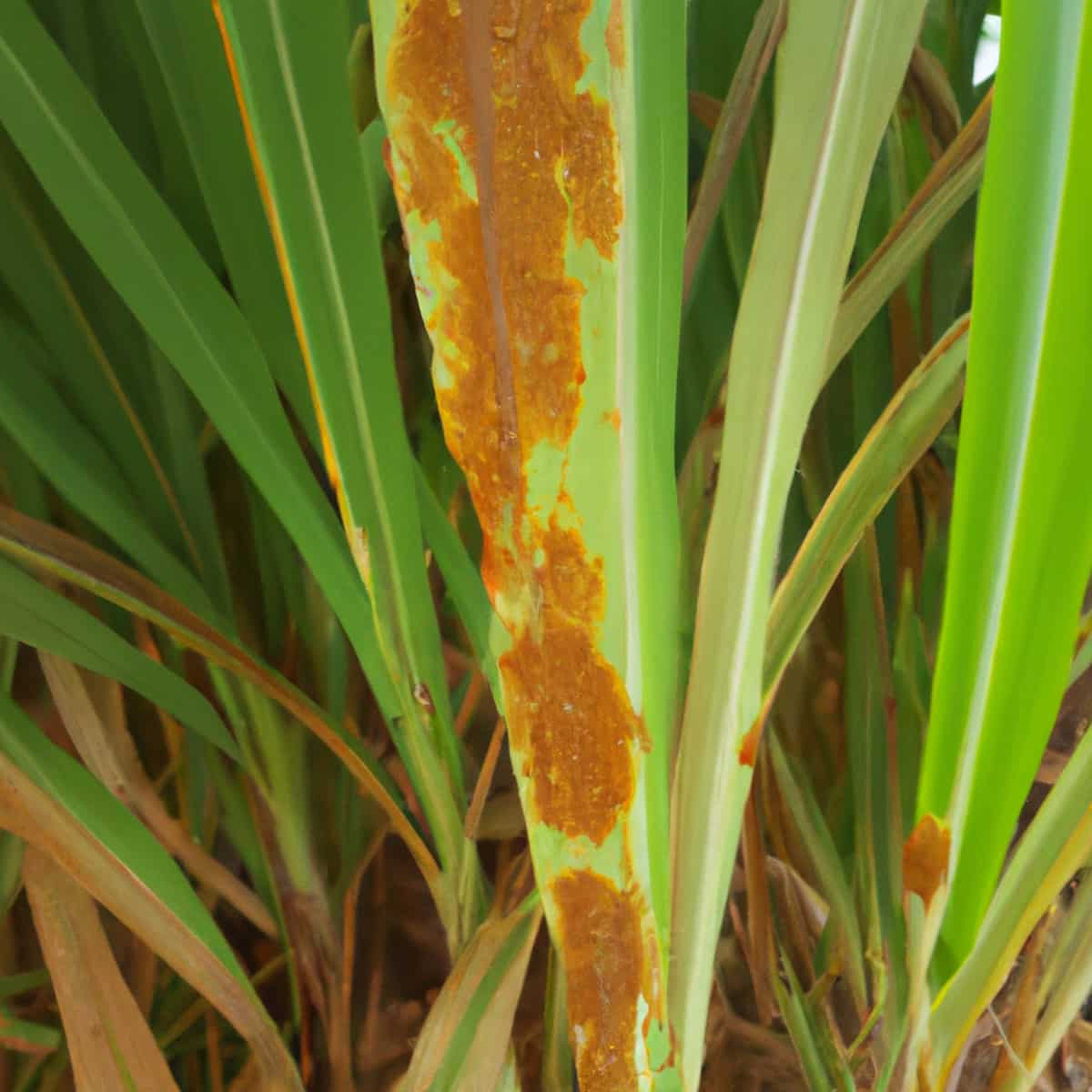Rust disease is a major concern for farmers of sugarcane worldwide. Rust is caused by a fungus that attacks the leaves of sugarcane plants, resulting in reduced yields and poor sugar quality. The characteristic orange-brown pustules of rust disease are visible on the foliage and stems of infected plants. Managing rust disease in sugarcane requires a combination of cultural, chemical, biological, organic, and natural control strategies.

These include the selection of varieties resistant to rust, proper irrigation and drainage, removing and destroying infected plant material, and applying fungicides. Biological control methods employ naturally occurring microorganisms to combat the rust fungus. In contrast, chemical control involves the use of synthetic fungicides. Natural control methods include predators and beneficial insects.
Organic control methods employ natural products and cultural practices to regulate rust disease. Effective rust management in sugarcane requires an integrated strategy incorporating multiple control methods, routine monitoring, and prompt intervention. Sugarcane growers can minimize the impact of rust disease and ensure healthy, productive crops by employing the appropriate management techniques.
Rust Management in Sugarcane
The Causal Organisms of Rust Disease
Puccinia erianthi is the pathogen that causes Rust Disease in sugarcane. The disease can be identified by its reddish-brown, elongated uredinia with hyaline to light brown paraphyses. The thick-walled, orange-brown, obovoid urediniospores have an echinulate surface with four to five equatorial pores. The teliospores measure 30-43 x 17-23 m and are dark brown, clavate, two-celled, and slightly constricted at the septum.
The Disease Cycle of Rust Disease
Rust Disease in sugarcane starts its life cycle with the germination of urediniospores, which are disseminated by wind and rain splash. The spores then cause the characteristic orange-brown pustules on the host plant. Additional urediniospores are produced and then released within these pustules to continue the cycle. Later-season teliospores are overwintering structures, enabling the disease to persist into the next growing season.
Causes/Conditions Favorable for Rust Disease in The Field
Rust Disease in sugarcane is caused by the fungus Puccinia kuehnii, which is spread by microscopic and resilient spores readily dispersed by wind and water splash and can survive in plant residues in the soil. The disease flourishes in warm, wet, and humid conditions during summer and early autumn, typically infecting canes older than six months. The optimal growth and transmission of the disease occur between 20 and 30 degrees Celsius and 70 to 90 percent relative humidity. High wind speed and prolonged cloudiness may aggravate the disease.
Symptoms of Rust Disease
- Early symptoms consist of tiny yellow patches on both leaf surfaces.
- Lesions transform into orange-brown patches up to 4 mm in length and 3 mm in width, typically near the leaf base.
- orange spores created on the underside of leaves
- Severe infection causes crop canopy reduction and the appearance of brown patches on the leaf sheath.
- Lesions enlarge and change color from red-brown to brown.
- A band of pale yellow-green develops around lesions.
- Severe infection causes numerous brown or rust-colored lesions on individual leaves.
- The aggregation of lesions into large, irregular necrotic areas can lead to premature mortality of the leaf.
- A severe infection can substantially reduce a plant’s number of living leaves.
In case you missed it: Whiteflies Management in Sugarcane: Symptoms, Treatment, Chemical, Biological, Natural, and Organic Control

Percentage of the Yield Loss Due to Rust Disease in Sugarcane
Rust Disease may greatly decrease sugarcane yield. According to studies, rust can reduce cane yield by up to 16% and total sucrose production by up to 14%. Additionally, the duration of the epidemic can affect the extent of the yield loss, with lengthier epidemics resulting in a greater reduction in total sucrose yield. Also found to be negatively correlated with rust intensity is stalk weight.
Rust Management in Sugarcane by Cultural Method
Cultural methods can greatly help sugarcane Rust Disease management. Utilizing resistant variants such as Co 91010 (Dhanush) and Co 81025 is an effective strategy. (Kalyani). These varieties have shown rust resistance and may help mitigate the disease’s impact on crop yield. In addition, crop rotation, timely planting and harvesting, and appropriate sanitation (removal of infected debris) can reduce the incidence and severity of the disease.
Rust Management in Sugarcane by Biological Method
Rust Disease in sugarcane can be managed using biological control methods. One approach is introducing natural competitors of the rust fungus, such as parasitic fungi and bacteria. It has been shown that Trichoderma spp. and Bacillus spp. have biocontrol potential against Rust Disease in sugarcane. These microorganisms can colonize sugarcane roots and Rust spots and inhibit the development and growth of the rust fungus.
Rust Management in Sugarcane by Chemical Method
Managing rust disease in sugarcane often involves the use of chemical control. However, it is important to consider an integrated strategy that includes preventive measures and biological treatments. Reduce yield losses with fungicides such as Strobilurin (e.g., pyraclostrobin, azoxystrobin) and triazole (e.g., metconazole, propiconazole).
During the developing season, these fungicides should be applied at three to four weeks intervals. Tridemorph and Mancozeb are also useful fungicides for managing rust. Tridemorph can be applied at 1 liter per hectare, whereas Mancozeb can be applied at 2 kilograms per hectare.
Rust Management in Sugarcane by Organic/natural Method
Organic/natural methods for controlling sugarcane rust involve using natural substances and techniques, such as neem oil, garlic extract, and compost tea, to control the disease. These environmentally friendly procedures pose no threat to humans or the environment.
In case you missed it: Smut Disease Management in Sugarcane: Symptoms, Identification, Treatment, Chemical, Biological, Natural, and Organic Control

Preventive Measures for Control of Rust Disease
In addition to resistant varieties, proper field sanitation and routine monitoring help prevent the spread and severity of rust disease. Reducing the amount of inoculum available for infection by removing infected plant debris and maintaining a clean growing environment. Early detection and treatment can prevent the disease from expanding and causing significant crop damage.
Conclusion
Rust disease in sugarcane, caused by the fungus Puccinia kuehnii, can result in substantial yield losses. Utilizing resistant varieties, practicing good sanitation, monitoring for signs of the disease, and employing chemical, biological, natural, and organic control methods are among the management strategies.
- Deworming Schedule for Dogs/Puppies: A Beginners Guide
- How to Prevent and Control Parasites in Goats
- Beneficial Insects in Pest Management
- Natural Solutions for Pest Control in Flower Gardens
- Types of Fungicides Used in Agriculture
- Common Issues in the Fruit Development Stage of Pomegranate Farming
- Fruit Development Issues in Papaya: Easy Solutions and Treatment
- Soil-Borne Diseases and How to Protect Your Plants
- Practices to Prevent Disease Spread in the Garden